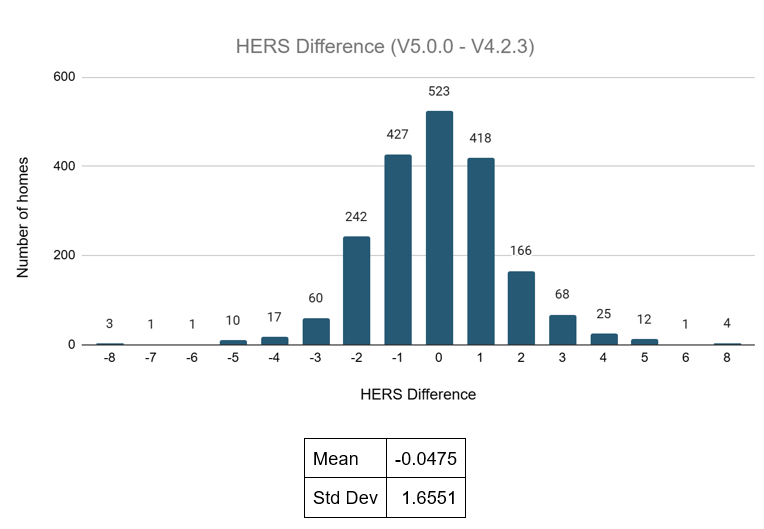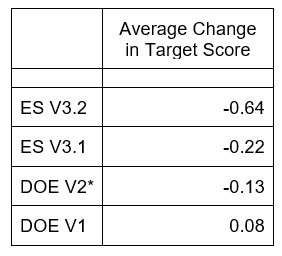What’s New in Version 5.0?
Ekotrope Version 5.0 launched in Beta on January 13, 2025. As we’re writing this article, Ekotrope Version 5.0 remains in beta testing. The full release date is yet to be determined but will be communicated as soon as it is finalized.
Changes in Version 5.0 are mainly driven by ANSI 301-2022 (including Addenda A & B) and updated test criteria in RESNET Publication 002-2024 (used for RESNET accreditation for software accuracy). This major update introduces significant modeling improvements that will affect HERS ratings and building energy code calculations for many homes. In this article, we’ll outline the impact of these changes and highlight key improvements and fixes. For a comprehensive list of all changes in Version 5.0, please refer to our Version Release Notes.
Impact on Results:
We randomly selected around 2,000 homes registered in 2024 and analyzed to see how results would change in Version 5.0 compared to our latest Version 4.2.3. Comparison results are as follows:
HERS:
Average change:
IECC:
IECC Performance Compliance:
The positive change in the compliance margin indicates that it is on average 1.42% (IECC 2021) and 0.49% (IECC 2018) easier to meet the performance path.
As mentioned above, changes to our heat transfer calculations and duct load calculations are playing a role in the compliance change.
DOE ZERH and ENERGY STAR:
In general, the target score decreases for ES and DOE Zero Energy Ready single family programs by less than one point and slightly increases for DOE V1. It is important to mention that the algorithm improvements are applied to both the target and proposed home, resulting in a very negligible change in the overall compliance.
Improvements in Algorithm:
Updates accounting for changes in ANSI 301-2022 (Addendum A&B):
ANSI 301-2022 includes some major changes to the HERS Rated and Reference Home definition along with modeling guidelines for software. We have updated the default values of framing fractions, solar absorptance values for exterior surfaces, fan efficacy of CFIS ventilation systems, thermostat setpoints, and untested forced-air distribution systems. We’ve also updated calculations for natural ventilation, default fan and pump power of GSHPs serving more than one unit, reference dishwasher usage, minimum required continuous ventilation rate, and tank losses for shared storage-type water heaters.
Building load calculations:
We’ve continued updating our energy modeling algorithm to improve the accuracy of the results in general. In Version 5.0, we have
Upgraded the heat transfer and solar-gain calculations through windows and skylights.
Replaced ASHRAE Standard 52-based duct system efficiency calculations with a more improved heat and mass balance model to account for unbalanced leakage more effectively.
Improved our overall heat transfer model through envelope components to directly account for short-wave and long-wave heat transfer on surfaces.
Corrected the load calculation for ceilings/roofs with eaves.
Please review our updated modeling guidelines for modeling ceilings/roofs with eaves on Freshdesk to accurately model them in Version 5.0.
Miscellaneous bug fixes:
Along with the modeling software improvements, we also included some bug fixes to our algorithm affecting energy calculations and reference homes. These corrections are as follows:
Fixed HVAC Grading calculations to exclude non-forced air systems (that were accounted for in some complex scenarios). Also fixed an issue with post construction leakage grade calculation.
Set the skylight adjacent shading factor to 1 for all reference homes.
Fixed the calculation of hot water usage for shared recirculation systems.
Corrected IECC 2021 total UA calculation to account for the window U-value altitude exception.
Corrected required ventilation CFM calculation for HERS Rated home.
As we continue to make efforts in enhancing and refining our software, we would like to express our sincere thanks to those users who have helped us identify and address issues within Ekotrope RATER by reporting them through our support channel. Your proactive involvement in helping us improve has been instrumental.
Lastly, we encourage you to share your valuable feedback with us to help us understand how this information has been helpful to you as you transition to the new version of Ekotrope. Please feel free to reach out to us at support@ekotrope.com if you have any questions or suggestions.



